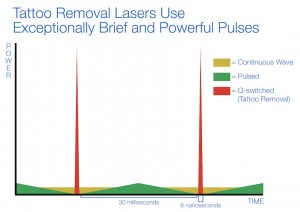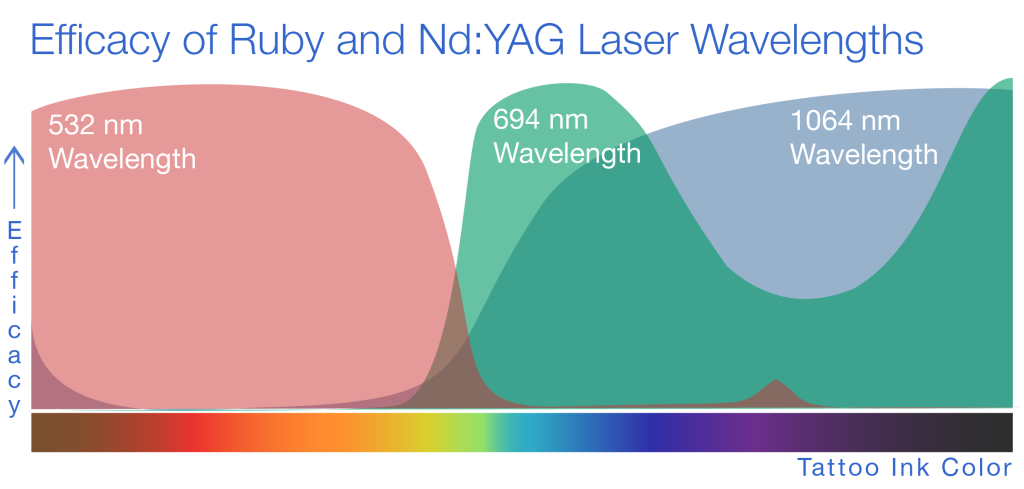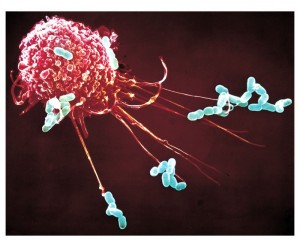How Does Tattoo Laser Removal Work
How laser tattoo removal works is a mystery to some. However, information technology'southward not magic, information technology's scientific discipline! Light amplification by stimulated emission of radiation tattoo removal is an exciting procedure for both patients and practitioners alike, just few people understand the science behind the procedure. This department of our website is an introduction to the physics of laser tattoo removal and explains why laser tattoo removal is the almost constructive option for unwanted ink.
The Basic Laser Tattoo Removal Procedure
During a light amplification by stimulated emission of radiation tattoo removal process, the practitioner guides a laser over the area of the tattoo. Unlike a laser arrow that produces a continuous beam of light, tattoo removal lasers produce pulses of light energy.
Each pulse of energy penetrates the skin and is captivated by the tattoo ink. As the tattoo ink particles absorb the energy, they heat up and so shatter into tiny fragments. And so, over the weeks following handling, the body'due south allowed system flushes the tattoo ink particles away from the location, lightening the advent of the tattoo. Each laser treatment breaks downwardly more and more of the tattoo ink until none remains.
What is Q-Switching?
Q-switching is a special type of laser pulse cosmos. Q-switched lasers produce intensely powerful, cursory pulses of energy – typically lasting only a few nanoseconds. This fast, intense pulse of energy is a big part of answering the question of how light amplification by stimulated emission of radiation tattoo removal works.

Q-switched lasers are especially useful for laser tattoo removal. Tattoo ink particles are extremely small (typically nanometers in diameter), and and so they demand to be heated for a very cursory menstruation of fourth dimension to warm up and explode.
In contrast, skin cells are much larger and would need to be heated for a longer period of time to be damaged. Since a Q-switched laser pulse is and so brief, it is capable of heating and shattering tattoo ink without heating the surrounding pare tissue. In essence, the briefness of the Q-switched laser pulse allows practitioners to selectively damage the tattoo ink particles while leaving the surrounding skin intact.
Targeting the Tattoo Ink
Tattoos come in every color imaginable. And, simply like all other objects around us, different colors of tattoos blot and reflect different wavelengths of light at different rates. For instance, a crimson tattoo looks red because it absorbs green light and reflects the cerise low-cal (which is what we see).

Because the goal of laser tattoo removal is to have the tattoo ink blot the light amplification by stimulated emission of radiation light, yous want to make certain that the wavelength you use is well-absorbed by the tattoo. Returning to the case of the reddish tattoo, the ruby-red ink should be treated with green laser light, equally it absorbs the green calorie-free (which makes the ink particles heat upwardly and shatter). Since the 532 nm wavelength of laser light visibly looks light-green, it is the ideal wavelength to use for treating a cerise tattoo.
When treating multicolored tattoos, it is of import to have access to a multifariousness of laser wavelengths for treatment versatility. The virtually mutual wavelengths used for laser tattoo removal are 1064 nm and 532 nm – they can care for 95%+ of tattoos. Additional wavelengths that some practitioners utilise are 755 nm and 694 nm – these wavelengths part very similarly and are useful for treating rare ink colors, such as bright blueish or green.
Letting the Body Practise Its Work
Tattoo removal is not an instant fix – it's normally a several-month commitment for patients. Near tattoos require betwixt 5 and 10 treatments to achieve complete removal, and the treatments must exist spaced at least 6 weeks apart. Patients often ask why tattoo removal requires and so many treatments and why they have to wait betwixt treatments. Every bit a practitioner, it's important to know the answers to these questions to provide an informative patient consultation.
 Laser tattoo removal requires multiple treatments because not all of the tattoo ink tin can be shattered in one treatment session. When a tattoo is applied, the ink is injected at different depths within the dermis. Equally the laser light is applied to the skin, the shallowest layers of ink in the dermis absorb the energy and shatter, only the deeper layers may not accept been affected. Only once the trunk flushes abroad the acme layers of ink can the deeper layers existence treated. In effect, every successive tattoo removal handling affects deeper and deeper layers of ink until none remains.
Laser tattoo removal requires multiple treatments because not all of the tattoo ink tin can be shattered in one treatment session. When a tattoo is applied, the ink is injected at different depths within the dermis. Equally the laser light is applied to the skin, the shallowest layers of ink in the dermis absorb the energy and shatter, only the deeper layers may not accept been affected. Only once the trunk flushes abroad the acme layers of ink can the deeper layers existence treated. In effect, every successive tattoo removal handling affects deeper and deeper layers of ink until none remains.
Patients need to wait betwixt treatments because information technology takes time for the body to flush away the shattered tattoo ink from the location of the tattoo. The procedure of flushing away the ink involves immune system phagocytic cells gradually moving the ink particles to the lymph nodes, where the pigments remain. Because the body can merely affluent away the ink at a certain speed, it'south beneficial to await equally long as possible between treatments to run across maximum fading from each session. Besides, the waiting period allows any scabs or blisters to heal, minimizing the possibility of over-treating the area and causing unwanted side effects.
A Quick Word of the Alternatives
 Light amplification by stimulated emission of radiation tattoo removal is the only constructive, not-invasive solution to unwanted ink. In decades past, people with unwanted tattoos had very few options – they could either undergo expensive excision surgery (which leaves a noticeable scar), use a damaging CO2 laser (which also leaves a big scar), or they would simply have to live with the tattoo.
Light amplification by stimulated emission of radiation tattoo removal is the only constructive, not-invasive solution to unwanted ink. In decades past, people with unwanted tattoos had very few options – they could either undergo expensive excision surgery (which leaves a noticeable scar), use a damaging CO2 laser (which also leaves a big scar), or they would simply have to live with the tattoo.
Nowadays, there are a variety of tattoo removal creams or injections on the marketplace, but these should all be avoided. The creams are simply ineffective – they have simply repackaged bleaching creams that cannot penetrate the dermis, which is where the tattoo ink is located. Injection methods are too highly suspect and often cause significant scarring.
Tattoos are popular, rates of tattoo regret are loftier, and light amplification by stimulated emission of radiation tattoo removal is the only true solution to unwanted tattoos.
Note:All of the topics mentioned on this folio (Q-switching, laser wavelengths, macrophages, etc.) will be discussed much more than thoroughly during the New Expect Laser Higher grade.

How Does Tattoo Laser Removal Work,
Source: https://newlooklasercollege.com/how-tattoo-removal-works/
Posted by: craigtralk1957.blogspot.com


0 Response to "How Does Tattoo Laser Removal Work"
Post a Comment